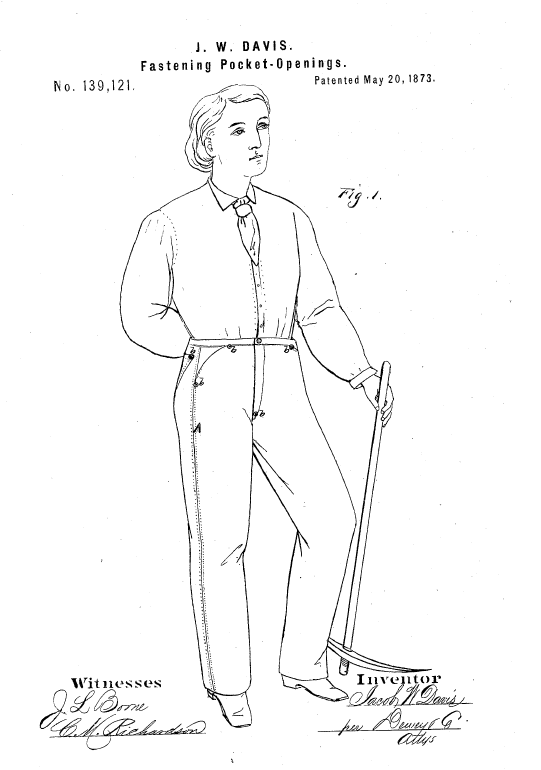13 August 2020
In present-day parlance, denim and jean or jeans are pretty much synonymous, referring to twilled, cotton cloth. Both words were also originally toponyms, or names of places, but different places and they once denoted different materials.
Of the two, jeans is older, dating to Middle English, where Gene or Jene referred to Genoa, the Italian city. Genoa was known for producing fustian, a thick, double-twilled cotton cloth, called jene (or geane) fustian and shortened to just jene or geane. The first use in English that we know of is from John Fortescue’s The Comodytes of Englond, written sometime before 1451, with a surviving copy from before 1500 in Oxford, Bodleian MS Laud Misc. 593. Fortescue describes the products coming out of Spain, in particular out of Castile. This particular reference to geayne could be to cloth in the style of Genoese fustian, or perhaps to genuine Genoese fustian with the Spanish acting as middlemen:
And owte of the kynges londe of Spayne cummythe goode dyght merchandyse, as owte of Castyll, Calyse, and Byskey the whiche three Contreys longe to hym, for owte of Castyll cummyth most plenty of
1 Oyle, 2 Wyne, 3 Salte, 4 Honye, 5 Wexe, 6 Conyfell, 7 Geayne, Cordewayne.
(And out of the king’s land of Spain comes good, finished merchandise, as out of Castille, Galicia, and Biscay, which three countries belong to him, for out of Castille comes a considerable amount of:
1 oil, 2 wine, 3 salt, 4, honey, 5 wax, 6 rabbit hide, 7 jean, leather)
In contrast, denim is a relatively more recent import into English. It is an Anglicization and clipping of the French serge de Nîmes, referring to twilled, woolen cloth, or serge, coming from the city of Nîmes. The earliest known English use of the phrase, in the form Serge Denim, appears in Edward Hatton’s 1695 The Merchant’s Magazine, sort of a handbook for would-be businessmen. Here he gives an example of an inventory entry:
Item. I have at Aleppo, consigned to Gilbert Gainwell my Factor there, these Norwich Wares remaining unsold, viz.
18 Serge Denims that cost 6 l. each, 108∷0∷0
30 Grograms at 3 l. per piece———— 90∷0∷0
40 Barateens at 3 l. 5 s. each————130∷0∷0
88 pieces in all, which cost——————————328:00:00
By 1771, the cloth was simply being called denim, as can be seen in this advertisement for a bankruptcy auction from 4 December of that year:
The whole genuine, large, and valuable stock of Meß. LAWRENCE and HARRISON, of White Horse-yard, Drury-lane, woollen-drapers and mens mercers, bankrupts. The lease of the premises and shop-fixtures will be put up Tomorrow, precisely at two o’clock; consisting of about
[...] shammy linings, padua serges, silk serges, denims, everlastings, flannels, bays [...] and various other articles.
And a few years after that, we see denim used to refer to cotton cloth. From a notice asking Londoners to be on the lookout for a criminal from 24 May 1777:
Public-Office, Bow Street,
May 23, 1777
WHEREAS JOSHUA CROMPTON, late a Sheriff’s and Marshalsea Court Officer, stands charged on oath before Sir JOHN FIELDING, on a violent suspicion of FORGERIES, to a very considerable amount.
[...]
The said Joshua Crompton [...] is supposed to be dressed in a round bob wig with two culs, or a club wig, a dark chocolate brown fly frock, with large white buttons of a sun pattern, a dark brown and orange striped Manchester velveret waistcoat, with buttons the same colour, a pair of drab coloured cotton denim breeches, with garters of the same, and new boots.
So that’s how the names of two cities, known for producing different types of textiles, became synonyms in English.
Sources:
Fortescue, John. “The Comodytes of Englond.” The Works of John Fortescue, vol. 1 of 2. London: 1869. 553. HathiTrust Digital Archive.
Gazetteer and New Daily Advertiser (London), 4 December 1771, 1. Gale News Vault.
General Advertiser and Morning Intelligencer (London), 24 May 1777, 1. Gale News Vault.
Hatton, Edward. The Merchant’s Magazine: or Trades-man’s Treasury. London: Chr. Coningsby, 1695, 159. HathiTrust Digital Archive.
Middle English Dictionary, 2018, s.v. Gene n.
Oxford English Dictionary, second edition, 1989, s.v. denim, n., jean, n.
Image credit: U.S. Patent and Trademark Office, Patent #139,121, 1873.

